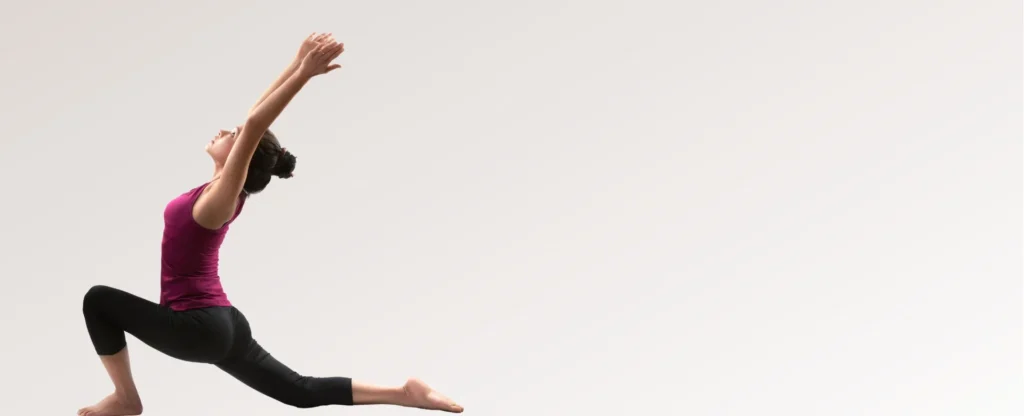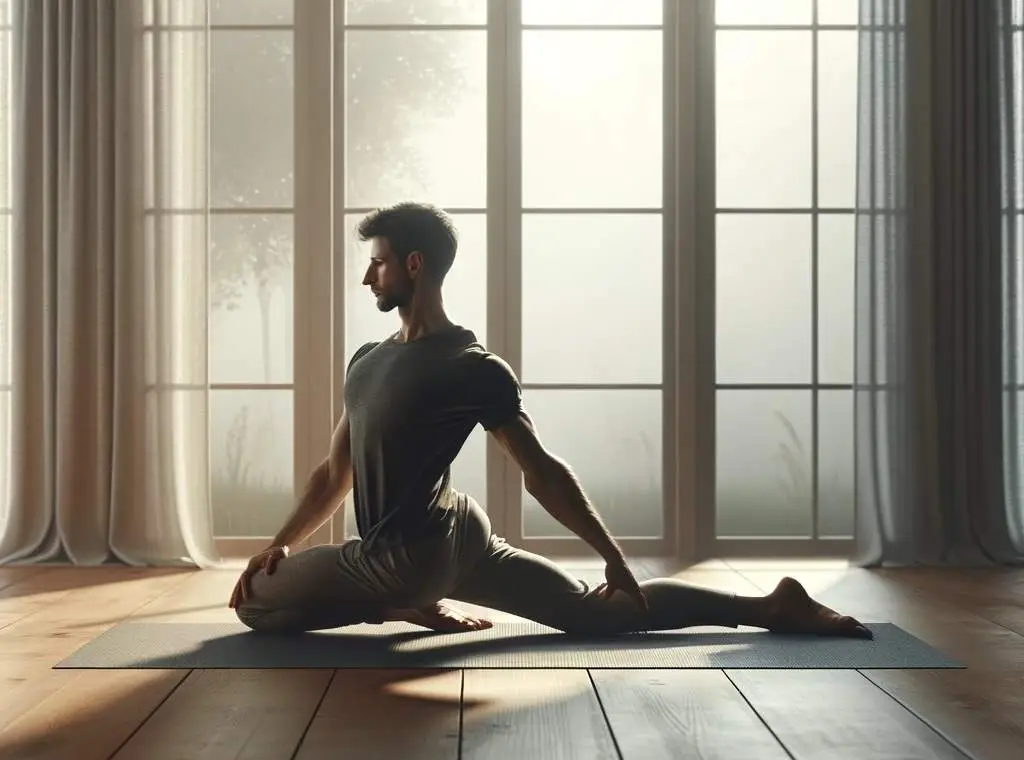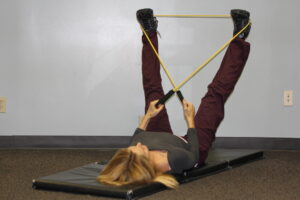Introduction
Welcome to a journey where tranquility meets vitality. Yoga, an ancient practice that’s more than just a series of stretches and poses, offers profound benefits for flexibility and stress relief. Whether you’re rolling out the mat for the first time or seeking new paths in your practice, understanding the “Yoga Benefits for Flexibility and Stress Relief” can transform not just your body, but your mind and spirit as well.
In a world that’s always on, where stress seems to be a constant companion, yoga offers a sanctuary. It’s not just about touching your toes or holding a pose; it’s about exploring the harmonious connection between mind and body. So, take a deep breath, and let’s delve into how yoga can be your ally in nurturing this balance.
Understanding the Holistic Approach of Yoga
Holistic Benefits of Yoga
Yoga stands out as a holistic practice that caters to both physical and mental well-being. The term “holistic” refers to an approach that considers the whole person—body, mind, emotions, and spirit. In the context of yoga, this means that your practice isn’t just a workout; it’s a way to harmonize all aspects of your being.
The Physical and Mental Symphony
- Physical: On the mat, you’ll stretch and strengthen your body, enhancing flexibility and building a solid core.
- Mental: As you flow from one pose to another, you’ll foster a sense of inner peace, learning to quiet the mind.
- Emotional: Regular practice can elevate your mood, teaching you to carry calmness into your daily life.
- Spiritual: For many, yoga becomes a spiritual practice, connecting them to a deeper sense of purpose and self.
Yoga invites you to a holistic experience, where the goal isn’t just to perform but to connect and grow.
Yoga Poses for Enhancing Flexibility

Body is not stiff, mind is stiff.
-Sri K. Jois
Unlocking Flexibility: Yoga Pose Exploration
Flexibility isn’t a prerequisite for yoga; it’s a result of it. As a beginner, you might feel intimidated by images of yogis twisted into pretzel-like forms. Fear not—yoga is for everyone. “Gentle yoga poses to improve flexibility and reduce stress” are the building blocks of a practice that meets you where you are.
Beginning with the Basics
- Mountain Pose (Tadasana): This foundational pose teaches you to stand with strength and stability, setting the stage for alignment.
- Downward-Facing Dog (Adho Mukha Svanasana): A staple in most yoga practices, this pose stretches the entire body and strengthens the arms and legs.
- Warrior II (Virabhadrasana II): Opens the hips and chest, enhancing lower body flexibility.
Tips for Practice
- Start Slow: Don’t rush. Take your time to get into and hold the poses.
- Breathwork: Your breath is a powerful tool to deepen your poses and enhance flexibility.
- Consistency: Regular practice, even for just a few minutes a day, can lead to significant improvements in flexibility.
Incorporating these poses into your routine can gradually enhance your flexibility, contributing to a feeling of lightness and freedom in your body.
The Impact of Consistent Yoga Practice on Mental Well-being
Mind-Body Connection in Yoga Practice
Regular engagement in yoga goes beyond physical benefits, deeply impacting mental well-being. “The impact of consistent yoga practice on mental well-being” is profound, offering a gateway to enhanced self-awareness and emotional balance. This consistent practice nurtures the mind-body connection, an integral aspect of yoga that helps in stress reduction and promotes a peaceful mental state.
Cultivating Mental Balance through Yoga
Yoga’s rhythmic movements, combined with breath control, guide you towards a meditative state, encouraging a sense of tranquility. This can be particularly beneficial in managing anxiety and depression, fostering a positive mood, and improving overall mental clarity.
Benefits of Consistent Practice
| Mental Benefit | Description | How Yoga Helps |
|---|---|---|
| Stress Reduction | Lowering of stress and tension levels | Through relaxation and mindfulness |
| Enhanced Concentration | Improved focus and attention | Via meditative aspects of practice |
| Emotional Equilibrium | Balanced emotional responses | Through increased self-awareness |
By integrating yoga into your daily routine, even for a short duration, you can tap into these mental health benefits, paving the way for a serene and centered mind.
Breathing Techniques for Stress Relief and Flexibility
Breath Control: A Key to Stress Relief and Flexibility
One of yoga’s most powerful tools for stress relief and increased flexibility is the practice of controlled breathing, or “pranayama.” “Breathing techniques in yoga for stress relief and increased flexibility” play a crucial role in both calming the mind and enhancing the physical practice. By learning to manage your breath, you can influence your nervous system, helping to reduce stress and prepare your body for deeper flexibility work.
Mastering Pranayama for Enhanced Well-being
Pranayama techniques vary in complexity, from simple diaphragmatic breathing to more advanced methods like alternate nostril breathing (Nadi Shodhana). These practices can significantly impact your stress levels and flexibility.
Pranayama Practices for Beginners
| Technique | Benefits | Practice Tips |
|---|---|---|
| Diaphragmatic Breathing | Engages the diaphragm, promoting relaxation | Breathe deeply, focusing on expanding the belly rather than the chest |
| Ujjayi Breath | Generates heat, aiding in muscle relaxation | Constrict the back of the throat to create a soft hissing sound on the exhale |
| Nadi Shodhana | Balances the left and right hemispheres of the brain | Gently close one nostril at a time, alternating breaths between each |
Regularly incorporating these breathing techniques into your yoga practice can help manage stress and contribute to improving flexibility.
Yoga Sequences for Overall Flexibility

Full-Body Flexibility: Yoga Sequence Exploration
Yoga offers a plethora of sequences designed to target overall flexibility. “Specific yoga sequences for enhancing overall flexibility” focus on moving the body through various ranges of motion, encouraging lengthening and strengthening of muscles. These sequences are crafted to help you develop flexibility in a balanced, holistic way.
Designing Sequences for Flexibility Gains
A well-rounded yoga sequence for flexibility might include poses such as standing forward folds, seated twists, and hip openers. Sequences can be modified to suit individual needs and levels, ensuring everyone from beginners to advanced practitioners can benefit.
Example of a Beginner Yoga Sequence for Flexibility
| Pose | Focus Area | Benefit |
|---|---|---|
| Cat-Cow Stretches | Spine flexibility | Warms up the spine and relieves tension |
| Standing Forward Fold | Hamstring and calf flexibility | Stretches the back of the legs and spine |
| Bound Angle Pose | Hip and groin flexibility | Opens the hips and improves circulation |
| Cobra Pose | Chest and abdominal flexibility | Strengthens the spine and opens the chest |
By practicing such sequences consistently, you can work towards a more supple and resilient body, with the added advantage of a calmer, more focused mind.
Stress Reduction through Mindfulness in Yoga
Mindfulness Practices for Stress Reduction
The practice of yoga is deeply intertwined with mindfulness, which is a mental state achieved by focusing one’s awareness on the present moment. “Stress reduction through mindfulness in yoga practice” is not just a concept; it’s a transformative experience that can alleviate the pressures of daily life. By integrating mindfulness into yoga, you deepen the connection between your body and mind, which in turn can significantly lower stress levels.
Mindfulness in Movement
Each yoga pose offers an opportunity for mindfulness, encouraging you to tune into the sensations, breath, and emotions that arise during your practice. This attentive state can help disengage the stress response, leading to a more relaxed and peaceful mindset.
Comparing Mindfulness Techniques in Yoga
| Technique | Stress Reduction Benefit | Practice Example |
|---|---|---|
| Focused Breathing | Calms the mind and reduces anxiety | Deep, even breaths synchronized with movement |
| Body Scanning | Releases physical tension and mental stress | Mentally scanning the body during Shavasana (Corpse Pose) |
| Visualization | Enhances relaxation and mental clarity | Visualizing a peaceful scene or light flowing through the body |
Incorporating these mindfulness techniques into your yoga sessions can help manage stress and contribute to a more serene and balanced life.
Meditation’s Role in Stress Relief and Flexibility
Inner Peace: The Role of Meditation in Yoga
Meditation is a cornerstone of yoga that complements the physical practices with profound mental benefits. “Incorporating meditation into yoga for stress and flexibility benefits” is an approach that enhances the yoga experience, offering a pathway to reduce stress and improve mental flexibility. This mental suppleness allows for a more adaptive and less reactive mindset, which can be especially beneficial in managing life’s stressors.
Meditation as a Tool for Flexibility and Relaxation
Engaging in meditation can help break down mental barriers to physical flexibility, as a relaxed mind often leads to a more relaxed body. By calming the nervous system, meditation can reduce muscle tension, aiding in the pursuit of physical flexibility.
Meditation Techniques for Enhanced Yoga Practice
| Meditation Type | Benefits | Practice Integration |
|---|---|---|
| Mindfulness Meditation | Increases present-moment awareness | Begin or end yoga sessions with 5-10 minutes of mindfulness |
| Loving-kindness Meditation | Fosters a sense of peace and compassion | Incorporate during restorative poses or Shavasana |
| Guided Imagery | Promotes deep relaxation | Use during meditation sessions after yoga practice |
By weaving meditation into your yoga practice, you can unlock greater levels of stress relief and enjoy a holistic sense of well-being that transcends the mat.
Yoga Therapy for Joint Mobility and Stress Resilience
Targeted Yoga Therapy for Physical and Mental Health
Yoga therapy is an adaptation of yoga practices for individuals with specific health issues. It is particularly effective for improving joint mobility and building stress resilience. “Yoga therapy for joint mobility and stress resilience” focuses on personalized sequences that cater to improving the range of motion. Also strengthening the support around the joints, while also employing strategies to manage stress.
Yoga Therapy for Joints and Stress Management
Yoga therapy’s targeted approach means that each session is tailored to address specific concerns, whether it’s tightness in the hips, stiffness in the shoulders, or chronic stress that manifests physically.
Yoga Therapy Approaches Compared
| Yoga Therapy Focus | Joint Mobility Benefit | Stress Resilience Benefit |
|---|---|---|
| Personalized Sequences | Addresses individual mobility issues | Customizes stress relief techniques |
| Gentle Movements | Enhances range of motion without strain | Encourages relaxation and eases tension |
| Therapeutic Poses | Targets and strengthens specific joints | Provides mental focus and alleviates anxiety |
Incorporating yoga therapy into your wellness routine can lead to improved joint health and a stronger, more resilient response to stress, contributing to overall quality of life and well-being.
Restorative Yoga for Promoting Flexibility and Relaxation
Gentle Restoration: The Role of Restorative Yoga
Restorative yoga is a specific style of yoga that focuses on relaxation and healing. It’s known for its capacity to induce a deep state of rest. This can significantly contribute to “The role of restorative yoga in promoting flexibility and relaxation.” Using props like bolsters, blankets, and blocks, restorative yoga supports the body in positions of comfort and ease to enhance the natural healing process.
Enhancing Flexibility Through Relaxation
Restorative yoga emphasizes the importance of stillness and patience, allowing you to slowly release into poses, which can lead to increased flexibility over time. Here’s how restorative yoga compares to more active styles in terms of promoting flexibility:
| Yoga Style | Intensity | Flexibility Benefit | Relaxation Benefit |
|---|---|---|---|
| Restorative Yoga | Low | Gradual increase in flexibility through prolonged gentle stretching | High, due to emphasis on relaxation and stress relief |
| Active Yoga Styles | High | Immediate improvement in range of motion through active stretching | Lower, as the focus is on movement and strength |
Key Restorative Poses for Flexibility and Relaxation
- Supported Child’s Pose: Gently stretches the hips, thighs, and ankles while calming the mind.
- Legs Up the Wall: Relieves tired leg muscles and improves circulation.
- Supported Bridge Pose: Opens the chest and hips, promoting relaxation of the central nervous system.
Incorporating restorative yoga into your practice can yield significant benefits for both flexibility and relaxation, offering a peaceful counterbalance to the stresses of daily life.
Personal Stories: Yoga’s Impact on Flexibility and Stress Relief
Real Experiences: Yoga Success Stories
Personal stories and testimonials can be powerful motivators. They highlight “Yoga’s impact on flexibility and stress relief” through real-life examples. Thus showcasing the transformative effects yoga can have on individuals from all walks of life.
Sharing the Yoga Journey
Compelling narratives about how yoga has improved flexibility and reduced stress can inspire others to begin or deepen their practice. These stories often reflect a diverse range of experiences, emphasizing that yoga is for everyone.
Comparative Impact of Yoga on Flexibility and Stress
| Individual | Flexibility Improvement | Stress Relief Experience | Yoga Practice Duration |
|---|---|---|---|
| John, 35 | Increased hamstring flexibility after 3 months | Significant reduction in work-related stress | 6 months, 3 times a week |
| Maria, 28 | Improved back flexibility, able to touch toes | Enhanced coping mechanisms for anxiety | 1 year, daily practice |
| Alex, 50 | Greater overall mobility and joint health | Lowered stress levels, better sleep quality | 2 years, 4 times a week |
These narratives offer a glimpse into the personalized and often profound effects of yoga on physical and mental health.
Conclusion
In conclusion, as we unravel the many layers of yoga, it becomes clear that its benefits extend far beyond the mat. The gentle stretches and calming practices pave the way for improved flexibility and stress relief, marking the essence of the “benefits of yoga.” Embracing this holistic approach, with the soothing rhythm of breath and the strength found in regular practice, opens doors to overall well-being. So, let’s make yoga a daily companion, allowing its positive impact to enrich our lives. Share your journey, inspire others, and together, let’s continue on this joyful path towards a healthier and more balanced life through the undeniable benefits of yoga.








